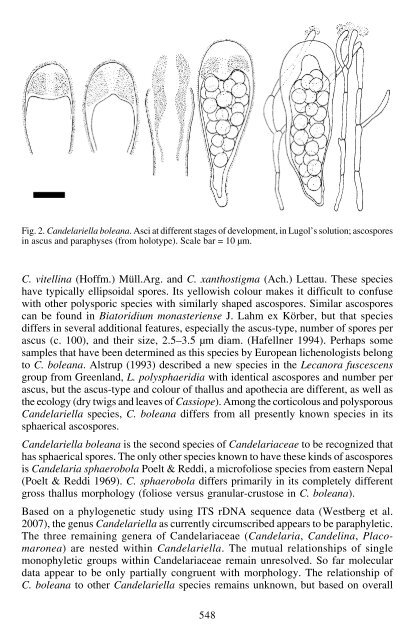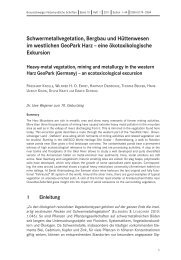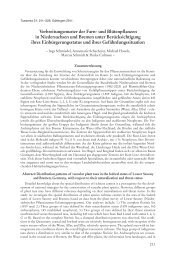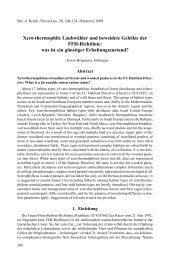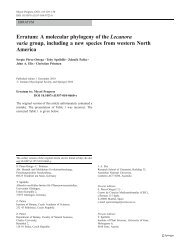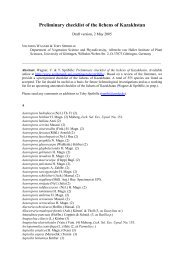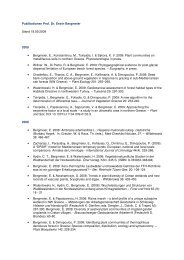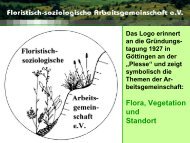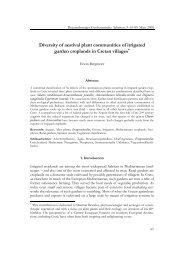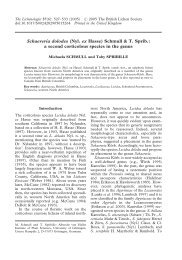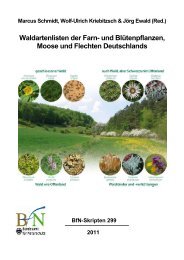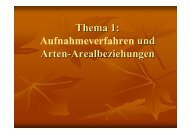Candelariella boleana, a new epiphytic species from southern and ...
Candelariella boleana, a new epiphytic species from southern and ...
Candelariella boleana, a new epiphytic species from southern and ...
You also want an ePaper? Increase the reach of your titles
YUMPU automatically turns print PDFs into web optimized ePapers that Google loves.
eschweizerbartxxx ingenta<br />
Fig. 2. <strong>C<strong>and</strong>elariella</strong> <strong>boleana</strong>. Asci at different stages of development, in Lugol’s solution; ascospores<br />
in ascus <strong>and</strong> paraphyses (<strong>from</strong> holotype). Scale bar = 10 μm.<br />
C. vitellina (Hoffm.) Müll.Arg. <strong>and</strong> C. xanthostigma (Ach.) Lettau. These <strong>species</strong><br />
have typically ellipsoidal spores. Its yellowish colour makes it difficult to confuse<br />
with other polysporic <strong>species</strong> with similarly shaped ascospores. Similar ascospores<br />
can be found in Biatoridium monasteriense J. Lahm ex Körber, but that <strong>species</strong><br />
differs in several additional features, especially the ascus-type, number of spores per<br />
ascus (c. 100), <strong>and</strong> their size, 2.5–3.5 μm diam. (Hafellner 1994). Perhaps some<br />
samples that have been determined as this <strong>species</strong> by European lichenologists belong<br />
to C. <strong>boleana</strong>. Alstrup (1993) described a <strong>new</strong> <strong>species</strong> in the Lecanora fuscescens<br />
group <strong>from</strong> Greenl<strong>and</strong>, L. polysphaeridia with identical ascospores <strong>and</strong> number per<br />
ascus, but the ascus-type <strong>and</strong> colour of thallus <strong>and</strong> apothecia are different, as well as<br />
the ecology (dry twigs <strong>and</strong> leaves of Cassiope). Among the corticolous <strong>and</strong> polysporous<br />
<strong>C<strong>and</strong>elariella</strong> <strong>species</strong>, C. <strong>boleana</strong> differs <strong>from</strong> all presently known <strong>species</strong> in its<br />
sphaerical ascospores.<br />
<strong>C<strong>and</strong>elariella</strong> <strong>boleana</strong> is the second <strong>species</strong> of C<strong>and</strong>elariaceae to be recognized that<br />
has sphaerical spores. The only other <strong>species</strong> known to have these kinds of ascospores<br />
is C<strong>and</strong>elaria sphaerobola Poelt & Reddi, a microfoliose <strong>species</strong> <strong>from</strong> eastern Nepal<br />
(Poelt & Reddi 1969). C. sphaerobola differs primarily in its completely different<br />
gross thallus morphology (foliose versus granular-crustose in C. <strong>boleana</strong>).<br />
Based on a phylogenetic study using ITS rDNA sequence data (Westberg et al.<br />
2007), the genus <strong>C<strong>and</strong>elariella</strong> as currently circumscribed appears to be paraphyletic.<br />
The three remaining genera of C<strong>and</strong>elariaceae (C<strong>and</strong>elaria, C<strong>and</strong>elina, Placomaronea)<br />
are nested within <strong>C<strong>and</strong>elariella</strong>. The mutual relationships of single<br />
monophyletic groups within C<strong>and</strong>elariaceae remain unresolved. So far molecular<br />
data appear to be only partially congruent with morphology. The relationship of<br />
C. <strong>boleana</strong> to other <strong>C<strong>and</strong>elariella</strong> <strong>species</strong> remains unknown, but based on overall<br />
548


